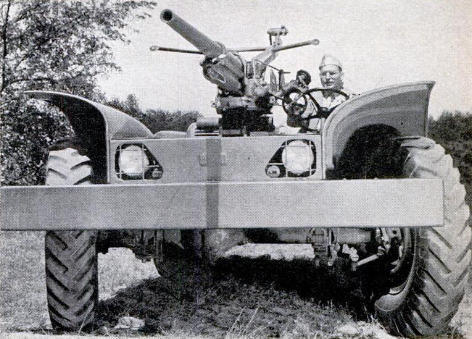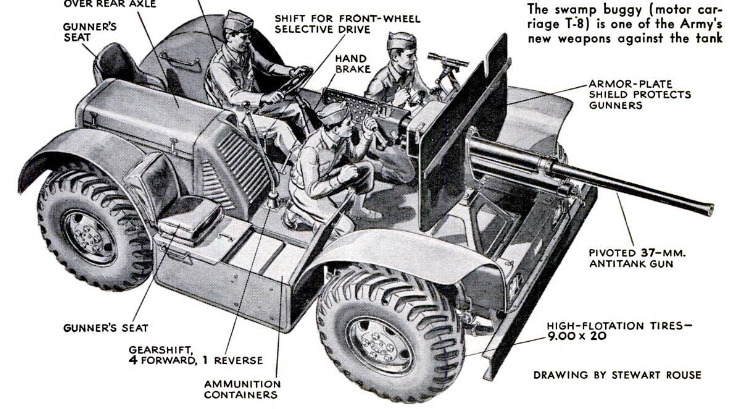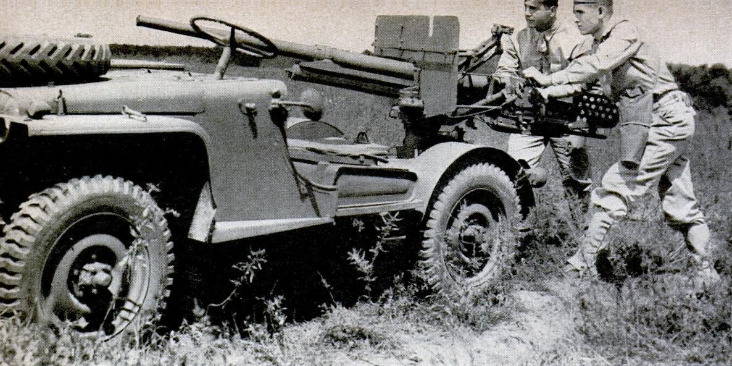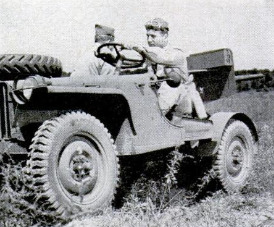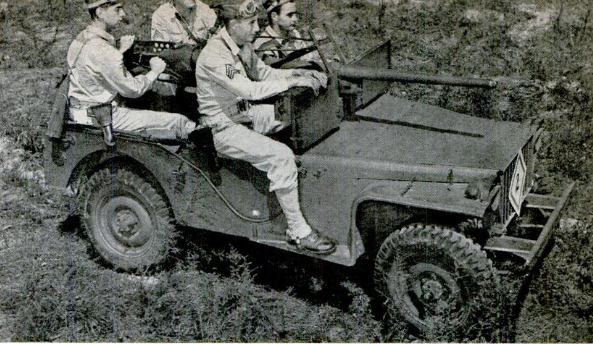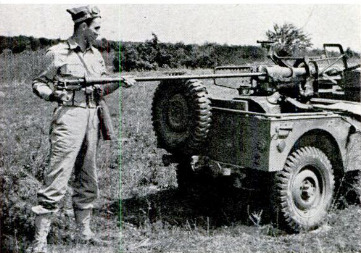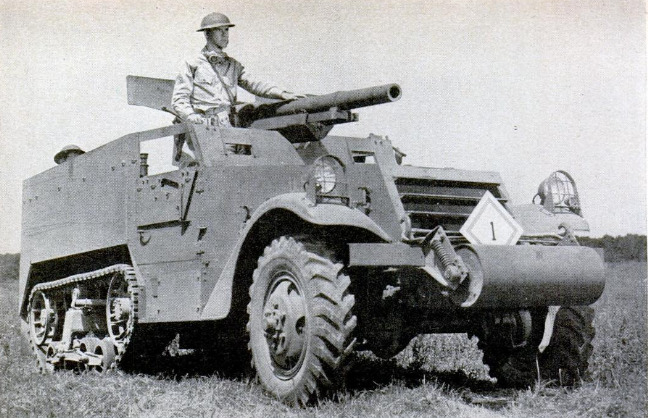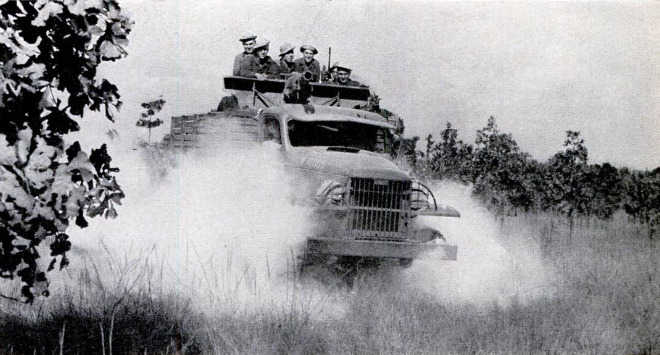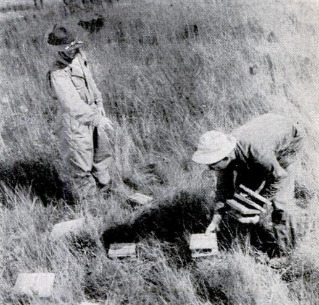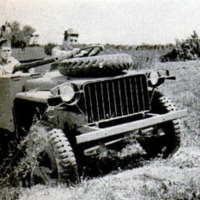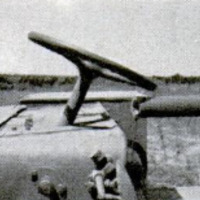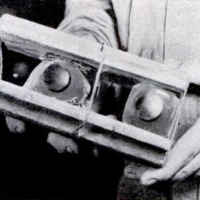-
Title (Dublin Core)
-
Tanks can be destroyed
-
Article Title and/or Image Caption (Dublin Core)
-
Title: Tanks can be destroyed
-
extracted text (Extract Text)
-
Land battleship meet their match in hard hitting and fast moving new gun carriers to run them down
WHEN America’s mechanized columns
clattered into battle in the recent war
games of the armies, they encountered a
new type of weapon and a new style of tac-
tics which on more than one occasion gave
their tank battalions a thorough kicking
around.
Fast, inconspicuous, and powerful, firing
from ambush and bursting forth in sudden
surprise raids, came swarms of tank destroy-
ers—armor-piercing guns on self-propelled
mounts—which could outspeed, outmaneu-
ver, and outshoot the heavy armored battle
wagons lumbering down upon them.
Tanks can be destroyed. And the Ameri-
can Army is getting ready to do that job,
without waiting for factory production to
put us on a basis of tank-for-tank equality
with potential enemies. The new weapons
for the purpose are simply ingenious adap-
tations of guns and carriers already avail-
able in vast quantities. The destroyer units
into which these guns are being organized—
with unprecedented mobility and concentra-
tion of fire power—are a purely American
innovation in the art of mechanized war.
They substitute an up-and-at-’em pugnacity
for the old antitank practice of placing guns
and waiting for an attack by the enemy’s
land battleships.
The basic heavy weapon of the new tank-
destroyer units is the old 75-millimeter gun.
The 75 is capable of stopping any tank—if
it can get into position and fire quickly
enough. But up to now it has been mounted
on wheels and towed behind a truck with
muzzle pointing to the rear. To move it,
either into action or away, precious minutes
must be lost in limbering and unlimbering.
The 75's new tank-destroyer mounting—
with muzzle forward, ready for point-blank
fire—is on one of the Army's new armored
half-track personnel carriers. The half-track
truck, with steering wheels in the front and
endless-tread tracks behind, can do 50 miles
an hour on the highway and can move rapid-
ly across country over terrain where a tank
can go.
Thus mounted, with modern fire control
permitting rapid aiming and firing by one
man, the 75 becomes a most formidable de-
structive weapon. Indeed, it practically be-
comes a myriad of such weapons, for the
half-track is already in mass production—
coming off the assembly lines of three big
truck factories.
That will permit its lavish use in concen-
tration of fire, and the Army is preparing
for that kind of use. The first provisional
tank-destroyer battalion, for instance, was
given a complement of 36 of these guns.
That is equivalent to the field-artillery power
hitherto assigned to a whole infantry divi-
sion! And if many are lost in battle, Amer-
ica can always make gun carriers a lot
faster than any other nation can make tanks.
Junior partner with the mobile 75's is the
37-millimeter antitank gun, souped up for
armor piercing and mounted on the new
bantam cars (jeeps) and a still newer mili-
tary vehicle known as the swamp buggy.
Unarmored, save for light shields across the
gun mounts, these light vehicles are to be
used for flank protection of the 75's and for
fast hit-and-run fighting. They are so small
and of such low silhouette that they can be
hidden in practically any patch of bushes.
The idea is for them to operate as sharp-
shooters, ready to cut and run for new cover
as soon as discovered.
The mounting of the 37 on the little jeep
is merely one new angle on the myriad uses
of the tiny car. But the swamp buggy,
known officially as the motor carriage T-8,
is something new, with exciting qualities
all its own.
The swamp buggy was developed as a
cargo carrier, by the Ford Motor Company.
It consists of little more than a platform,
four big wheels, and an engine (the new
Ford in-line, six-cylinder.) The whole thing
stands less than four feet high, and most of
this altitude is in the balloon tires (9.00 by
20) which are 38 inches in diameter. The
engine rests over the rear axle, at the right,
and driver and gunners sit beside it. The
antitank gun is mounted all by itself on the
forward deck, ready for instantaneous ac-
tion. With wide selective range of power
and speeds, it can pass almost any pleasure
car on the open road and can ride its big
tires over almost any kind of ground—in-
cluding soft spots where a tank would bury
itself. It is so low it can hide in a weed
patch.
Before this past year, the obvious way of
combatting tanks was to build better tanks
and more of them. But as a result of the
tank shortage a whole flood of Army ingen-
uity was turned loose and within a few
months the basis had been laid for a whole
new technique of tank fighting with self-
propelled guns. Even now, before the quick-
ly devised weapons have been provided to
troops in any great numbers, it is obvious
that they are only a beginning.
No one man or group of men is responsible
for this development, but one example of
the kind of creative work that went into it
is the case of Col. B. Q. Jones. Colonel Jones,
veteran of the Air Corps, was assigned last
year to cavalry at Fort Bliss; and incident
to his duties was the testing of that new-
fangled little car, the bantam jeep. In the
process he developed an idea all his own.
Last February he took the rear end of an
old Ford truck, cut the differential casing in
two, and turned it into a mount for a 37-
millimeter gun. Then he took out the rear
seat of a jeep, and in its place he put the
gun, so swiveled that it could fire in several
directions from the parked car. At first,
when shooting sidewise, the little car would
jump about seven inches with each shot;
but when the mount was cut down a few
inches she stood solid, absorbing recoil in
her tires. There was a lot of skepticism, of
course, about so insubstantial a mount for
an artillery piece. But when the Jones gun
hit a gasoline barrel three times out of four,
at a range of 500 yards, it certainly was not
to be ignored. Colonel Jones went to Wash-
ington, assigned to G-3 of the War Depart-
ment. There, in the Training and Operations
Division, he found a whole group of men
thinking along the same lines as himself.
Soon Ordnance came out with its own
version of a 37 on a jeep. This gun sits on a
higher mount than the Jones gun, firing for-
ward over the engine. In rapid succession
came the development of the half-track and
the swamp buggy as gun mounts. Designs
are being made for a heavier jeep, better to
stand a heavy gun.
Rapidly also came organization of new
outfits to use the new weapons. Up to this
time, the basic unit for protection against
tanks had been the antitank company of
each infantry regiment, charged with the
local protection of its own troops. Last
July, after a four-day pow-wow of antitank
men, the War Department embarked on the
formation of 23 provisional antitank battal-
ions, designed for the protection of larger
units. Drawing on its own field artillery,
each infantry division formed such a battal-
ion. Nine still stronger battalions, for the
protection of army corps, were put together
from the field-artillery brigades, and in-
structed to work together in groups of three
ready to take the initiative against any
strong enemy armored column.
The new guns weren't ready yet, but soon
old-fashioned 75's were hoisted into 2 1/2-ton
trucks and lashed down with muzzles point-
ing forward. In other trucks, pine logs were
set up as simulated guns. While waiting for
armament, the battalions went to work on
tactics. A whole new structure of antitank |
defense and tank destruction had been su-
perimposed upon the Army, |
At the base were the old antitank com-
panies, the same as they had always been.
Then each division had its provisional anti-
tank battalion. In a square division this
consisted of two batteries of 12 37-milli- |
meter guns and two batteries of 75's, with
eight guns each. In addition the battalion
had a company of engineers, equipped with
thousands of mines to be strewn thickly in
the path of probable tank attack. This divi-
sional antitank battalion, numbering about
475, has the function of protecting its own
division from any mechanized break-through,
after the fashion of halfbacks on a football
team.
The antitank battalions from the field-
artillery brigades, organized in GHQ groups
and armed entirely with 75’s, were assigned
the more aggressive role of seeking out and
combatting any major mechanized attack.
Then, on top of all this, came the General
Staff’s real innovation, the provisional GHQ
tank-destroyer battalion, of which it is
planned to mobilize a large number. Note
that it is not “antitank.” The whole philoso-
phy of antitank tactics in the past has been
to meet the enemy when he attacks. The
whole idea of the tank-destroyer outfit is
that it shall go out
and find the enemy and destroy him before
he strikes. It embodies the old military prin-
ciple that the best defense is to hit the other
guy first.
As planned today the tank destroyer bat-
talions will be as innocent of self-protection
as the naval destroyers and light cruisers of
the battle fleet. With its thirty-six 75's and
eighteen 37's, the battalion as now set up
carries defensively eight 37-millimeter anti-
aircraft guns and .50 caliber machine guns
for protection against ground - strafing
planes. For advance reconnaissance, it has
ten light tanks, armored, but the main body
is for speed and striking power alone. Its
counterpart exists in no army in the world,
and it is a typically American conception.
To paraphrase the oft-quoted Civil War gen-
eral, it will be out to get there firstest with
the mostest guns.
-
Contributor (Dublin Core)
-
Hickman Powell (article writer)
-
Language (Dublin Core)
-
Eng
-
Date Issued (Dublin Core)
-
1941-12
-
pages (Bibliographic Ontology)
-
75-79,220
-
Rights (Dublin Core)
-
Public domain
-
Archived by (Dublin Core)
-
Sami Akbiyik
 Popular Science Monthly, v. 139, n. 6, 1941
Popular Science Monthly, v. 139, n. 6, 1941

